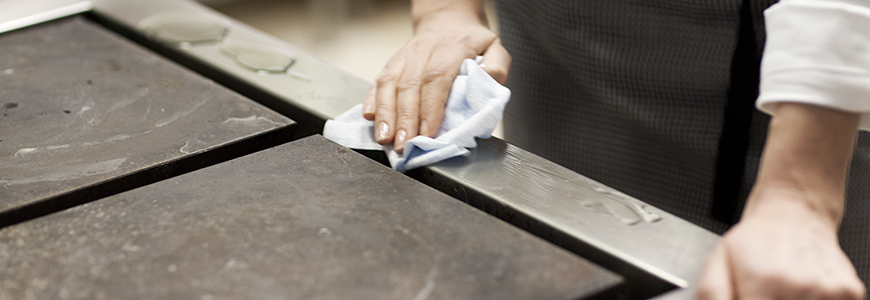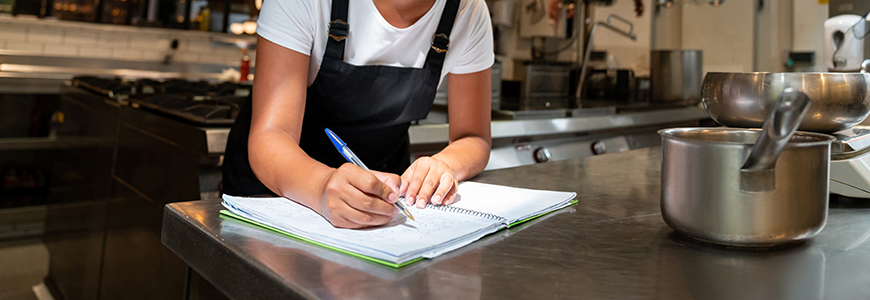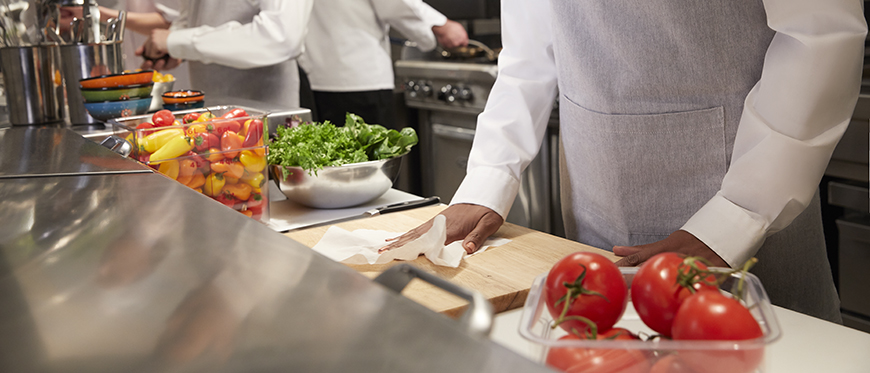Surface hygiene is, of course, an important pillar of food safety—and customer perceptions. The CDC emphasizes that restaurants and bars should clean and disinfect frequently touched areas “at least daily, and as much as possible.”1 Meanwhile, a recent survey found that 57% of customers would feel more comfortable in restaurants where retailers and operators regularly and visibly wipe down tables, kiosks, and other things people touch.2 Working surfaces always need to be ready to use.
First, it’s important to understand the differences between cleaning, sanitizing, and disinfecting.
Cleaning, sanitizing, and disinfecting differences

- Cleaning removes dirt and soil, making the surface look clean. During the busiest part of service, cleaning may be all you’re able to do, at least for certain surfaces.
- Sanitizing is removing and lowering the numbers of germs to a safe level, as judged by public health standards.
- Disinfecting uses chemicals to kill germs. If you want to get your visibly clean surface hygienically clean, you must reduce the microbial load by sanitizing or disinfecting after you’ve cleaned.
Five-part strategy for surface hygiene
1. Clean as you go policy

The clean as you go policy involves taking opportunities to clean continually throughout the busy working day. Everyone working in the kitchen is responsible for cleaning his or her area throughout the shift. For that to happen, adequate cleaning supplies need to be readily available and close to working hands (i.e., not in a cleaning cabinet). Double check that staff are using appropriate, designated cleaning tools.
2. Systematic cleaning

Systematic cleaning involves deep cleaning surfaces. To make sure that you don’t forget anything, use checklists to stay on top of deep cleaning tasks. Checklists should be detailed, including:
- What needs to be cleaned.
- When it should be cleaned.
- How often it should be cleaned.
- Who is responsible.
- What cleaning method should be used.
3. Take care of your kitchen tools
Taking good care of your kitchen tools not only promotes surface cleaning – it can help prevent cross-contamination. Tips for making that happen include:

- Planning ahead to prep ready-to-eat food separately and at different times than raw foods (especially meat, seafood and poultry).
- Keeping tools within small areas. For example, have color-coded areas in the kitchen. Make sure that the blue area has blue tools and they don’t wonder into the red area.
- Changing your cloths, mops or any form of textile frequently (or use disposables).
- Establishing a follow-up process to ensure that you don’t accidentally use a rag that’s been laying around for a week.
4. Document your cleaning efforts
It’s important to document cleaning efforts so that you have records to show and can follow-up that cleaning is being done in the correct fashion. You may already be using checklists. We recommend reviewing your checklist given that the environment is riskier now than it was before. Questions to ask during the pandemic may include:
- Do you need to clean new items (e.g., door handles)?
- Do you need to clean more often?
- Do you need to clean in a different way?
- Do you need to change your cleaning tools? Consider using disposable cleaning tools versus reusable for the duration of the pandemic.
5. Training
It doesn’t matter how good your plan and checklists are unless everyone is following them. Therefore, review training with your staff. Does everyone understand how to properly use the checklists and clean tools properly? Does everyone understand what their cleaning responsibilities are? Follow up rigorously on enforcing the checklist compliance.
While you’re at it, reinforce hand hygiene compliance. Employees must remember to wash hands when changing tasks. Sometimes people need reminders, especially when times are busy.
When it comes to surface cleaning, it is, of course, not only how you do it – but where. This includes the kitchen, the front-of-the-house, and the restrooms. Where to start? Take next steps with this surface cleaning checklist.
Sources
1 CDC: Considerations for Restaurants and Bar Owners
2 Datassential Report 1 | 3.12.20 The Impact on Eating: COVID-19: Coronavirus & the Impact on Eating
National Food Safety Month 2020: From Outbreaks to Pandemics: Why the Essentials of Managing Food Safety Risk Matter
